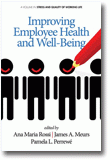
Improving Employee Health and Well Being
Edited by:
Ana Maria Rossi, International Stress Management Association
James A. Meurs, University of Mississippi
Pamela L. Perrewé, Florida State University
A volume in the series: Stress and Quality of Working Life. Editor(s): Ana Maria Rossi, International Stress Management Association. Charn P. McAllister, Northern Arizona University. Jeremy D. Mackey, Auburn University.
Published 2013
It is widely recognized that healthy employees are happier and more productive at work. Experiencing stress at work decreases employee’s health and affects their well-being. The American Institute of Stress (AIS) estimated that US$ 300 billion/year are spent on conditions related elevated stress levels. Stress is an everyday part of life for most people in any society. However, when people experience too much stress, serious psychological and physical health problems can result. This book provides an in-depth examination of how to improve employee health and well-being. It features the research, knowledge, and experience presented by over two dozen stress scholars who author twelve chapters.
Not all stress can be prevented, and many jobs are highly demanding in multiple ways. Thus, if you cannot prevent stress, effort should be put into understanding occupational stressors and improving employee health. This book on employee health and well-being is aimed at assisting occupational health professionals and academics find ways to help employees managing stress and improve their health. But, it also can be helpful for employees to learn to how they can improve their occupational health. The research findings and knowledge offered by these well-respected leaders in stress scholarship give both employers and employees an awareness of the implications of workplace stress on employee health, and provides avenues for both organizations and individuals to improve worker well-being.
CONTENTS
Foreword. Preface. Section I: The Role of the Individual in Organizational Stress and Well-Being. Workplace Politics and Well-Being: An Allostatic Load Perspective, Christopher C. Rosen and Daniel C. Ganster. Occupational Demands, Environmental Resources, and Personal Resources Effects on Presenteeism and Health, Lois E. Tetrick and Clifford R. Haimann. Quality of Working Life: Meaning and Sense for Companies and Employees, Raphael Henrique C. Di Lascio. Evaluation of Stress in Nursing Students: Analysis Standardization, Rodrigo Marques da Silva, Carolina Tonini Goulart, Luis Felipe Dias Lopes, Ana Lucia Siqueira Costa, and Laura de Azevedo Guido. Building Resilience to Improve Employee Well-Being, Matthew R. Leon and Jonathon R. B. Halbesleben. The “Right” Tools: Stress Response Lessons from the Opposite Sex, Faye K. Cocchiara, David J. Gavin, Joanne H. Gavin, and James Campbell Quick. Section II: Examining the Social Aspects of Occupational Stress. When Dealing with Quality of Working Life, It Is Impossible to Forget: Regrettably, Taylor Is Still Alive and Kicking! José Vieira Leite. Socio-Environmental Responsibility in Public Administration, Marcos Weiss Bliacheris. Section III: The Role of Prevention and Intervention in the Quality of Working Life. SAV-T First: A Risk Management Approach to Workplace Violence, E. Kevin Kelloway, Kate Calnan, Jane Mullen, and Mike Teed. How to Encourage Changes in Behavior through Interventions Integrated into Quality of Life Programs within Companies, Alberto José N. Ogata and Sâmia Aguiar Brandão Simurro. Quality of Life and Self-Care in Civil Servants: Prevention and Intervention, Dulce Helena C. Hatzenberger and Mary Sandra Carlotto. Job Stress Prevention: An Overview of Approaches, Joseph J. Hurrell, Jr. and Steven L. Sauter. About the Editors. About the Contributors.
REVIEWS
"This newly published volume from the Stress and Quality of Working Life series contains a collection of brief, straightforward, and academically oriented chapters that successfully tackles the topic of employee health and well-being from various perspectives. Editors Rossi, Meurs, and Perrewe´ have effectively compiled independently written chapters that logically flow from the individual micro level to the social and legal macro level. Both academicians and corporate managers will gain a useful awareness of how employee health and well-being is currently studied and analyzed and how to use this information to design programs and procedures that can potentially improve the health and well-being of employees." William P. Schaefer George Mason University in World Medical and Health Policy (Read full review)
-
Paperback9781623965174
Web price: $45.04 (Reg. 52.99)
-
Hardcover9781623965181
Web price: $80.74 (Reg. 94.99)
- eBook9781623965198

- BUS030000 - BUSINESS & ECONOMICS: Human Resources & Personnel Management
- HEA038000 - HEALTH & FITNESS: Work-Related Health
-
 Coping and Prevention
Coping and Prevention
-
 Stress and Quality of Working Life
Finding Meaning in Grief and Suffering
Stress and Quality of Working Life
Finding Meaning in Grief and Suffering
-
 Stress and Quality of Working Life
Coping at Work and at Home
Stress and Quality of Working Life
Coping at Work and at Home
-
 Stress and Quality of Working Life
Current Perspectives in Occupational Health
Stress and Quality of Working Life
Current Perspectives in Occupational Health
-
 Stress and Quality of Working Life
The Positive and The Negative
Stress and Quality of Working Life
The Positive and The Negative
-
 Stress and Quality of Working Life
Interpersonal and Occupation‐Based Stress
Stress and Quality of Working Life
Interpersonal and Occupation‐Based Stress
-
 Stress and Quality of Working Life
Conceptualizing and Assessing Stress
Stress and Quality of Working Life
Conceptualizing and Assessing Stress

